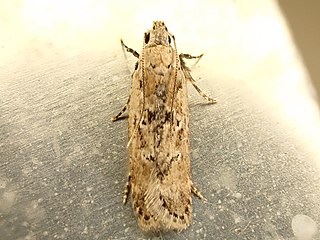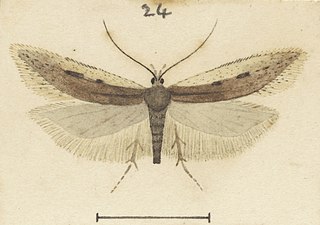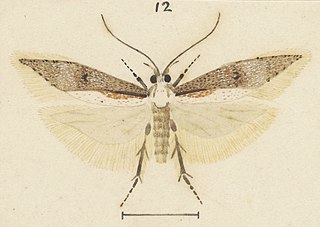
Kiwaia is a genus of moths in the family Gelechiidae. Two subgenera are currently recognised, (i) the nominotypical subgenus with 25 species from New Zealand, and (ii) subgenus Empista with 4 species from the Palaearctic Region.

Izatha prasophyta is a moth of the family Oecophoridae. It is endemic to New Zealand, where it is known from the North Island, except Hawkes Bay or the Wairarapa. Larvae likely feed on rotting wood although larvae of this species have been reared on the fruiting body of the bracket fungus Bjerkandera adusta. Adults are on the wing from November to February.

Batrachedra tristicta is a species of moth in the family Batrachedridae. It is endemic to New Zealand and has been found in both the North and South Islands. The larvae feel on the flowers and seed heads of rushes in the genus Juncus. The adults of this species are on the wing in March.

Heterocrossa gonosemana is a species of moth in the family Carposinidae. It is endemic to New Zealand.

Pyroderces aellotricha, also known as the Cosmet moth, is a moth of the family Cosmopterigidae. It is found in New Zealand, in Australia and the Cook Islands.

Microcolona limodes is a species of moth in the family Elachistidae. It is endemic to New Zealand. The larvae of this moth eat the seeds of endemic Myrsine species.

Anisoplaca achyrota is a species of moth in the family Gelechiidae. It was first described by Edward Meyrick in 1885 and is endemic to New Zealand. This species has been observed in both the North and South Islands and inhabits native forest. The larvae of this species feed on the green seeds of Hoheria angustifolia and as such is regarded as an indicator species for mature native forest. The adults of the species are commonly on the wing from December until February and are attracted to light.

Anisoplaca acrodactyla is a species of moth of the family Gelechiidae. It was described by Edward Meyrick in 1907 and is endemic to New Zealand. This species has been observed in South Island as well as in the North Island. Larvae feed on species in the genera Hoheria and Plagianthus including the species Plagianthus regius'.

Kiwaia aerobatis is a moth in the family Gelechiidae. It was described by Edward Meyrick in 1924. It is found in New Zealand.

Kiwaia brontophora is a species of moth in the family Gelechiidae. It was described by Edward Meyrick in 1885. It is found in New Zealand.

Kiwaia glaucoterma is a species of moth in the family Gelechiidae. It was described by Edward Meyrick in 1911. It is endemic to New Zealand.

Kiwaia heterospora is a moth in the family Gelechiidae. It was described by Edward Meyrick in 1924. It is found in New Zealand.

Kiwaia lapillosa is a moth in the family Gelechiidae. It was described by Edward Meyrick in 1924. It is found in New Zealand.

Kiwaia monophragma is a moth in the family Gelechiidae. It was described by Edward Meyrick in 1886. It is found in New Zealand.

Kiwaia parapleura is a moth in the family Gelechiidae. It was described by Edward Meyrick in 1886. It is found in New Zealand.

Kiwaia pharetria is a species of moth in the family Gelechiidae. It was described by Edward Meyrick in 1885. It is endemic to New Zealand.

Kiwaia schematica is a moth in the family Gelechiidae. It was described by Edward Meyrick in 1885. It is found in New Zealand.

Kiwaia thyraula is a moth in the family Gelechiidae. It was described by Edward Meyrick in 1885. It is endemic to New Zealand.

Aristotelia paradesma is a moth of the family Gelechiidae. It was described by Edward Meyrick in 1885 and is endemic to New Zealand. This species has been observed on both the North and South Islands. The larvae feed on Coprosma species creating and living in stem galls. The adults are on the wing from November to March and are attracted to light.

Megacraspedus calamogonus is a moth of the family Gelechiidae. It was described by Edward Meyrick in 1885. It is endemic to New Zealand.




















